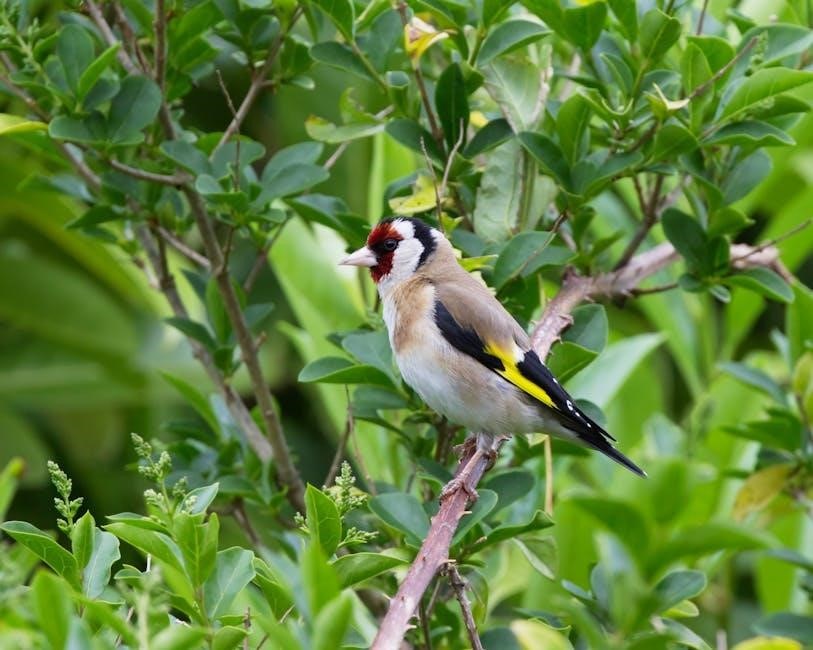The Beak of the Finch by Jonathan Weiner explores evolutionary biology through Darwin’s legacy and the Grants’ groundbreaking research on Galápagos finches, offering a PDF study guide for deeper insight.
Overview of the Book
The Beak of the Finch by Jonathan Weiner masterfully blends modern evolutionary research with historical context, focusing on the iconic Galápagos finches. The book recounts the groundbreaking work of biologists Peter and Rosemary Grant, whose decades-long study on Daphne Major Island reveals real-time evolutionary changes. Weiner seamlessly connects Darwin’s original insights to contemporary molecular biology, offering a compelling narrative of how species adapt to environmental challenges, making it accessible to both scientists and general readers.
Significance in Evolutionary Biology
The Beak of the Finch bridges Darwin’s theory with modern evolutionary research, showcasing the Grants’ longitudinal study on Galápagos finches. Their work demonstrates observable evolutionary changes, validating natural selection’s role in adaptation. By linking historical observations with molecular biology, the book provides direct evidence of species’ responses to environmental pressures, making it a landmark in evolutionary biology and education.

Charles Darwin and the Galápagos Finch
Charles Darwin’s encounter with Galápagos finches during his voyage on the Beagle inspired his early musings on evolution, later influencing his groundbreaking theory of natural selection.
Darwin’s Encounter with Finches
Darwin’s collection of Galápagos finches during his Beagle voyage laid the groundwork for his evolutionary theories. Initially, he didn’t recognize their significance but later noticed variations in beak shapes and sizes, sparking questions about adaptation and species divergence. These observations became foundational to his theory of evolution, connecting finch diversity to environmental pressures and natural selection.
Influence on Darwin’s Theory of Evolution
Darwin’s observations of Galápagos finches fundamentally shaped his theory of evolution. The diversity in finch species and their beak adaptations led him to question the fixity of species. This encounter inspired his ideas on natural selection and adaptation, forming the cornerstone of his groundbreaking work, On the Origin of Species. The Grants’ later research validated these concepts, demonstrating evolution in action.

The Research of Peter and Rosemary Grant
Peter and Rosemary Grant’s groundbreaking research on Galápagos finches spans over twenty years, meticulously monitoring generations to document evolutionary changes and adaptation in real time.
Their Contribution to Evolutionary Biology
Peter and Rosemary Grant’s research revolutionized evolutionary biology by providing empirical evidence of natural selection in action. Their long-term study on Daphne Major Island demonstrated rapid evolutionary changes in finch populations, linking environmental pressures to observable adaptations. By combining field observations with molecular analysis, they advanced understanding of species variation and adaptation, bridging Darwin’s theoretical framework with modern evolutionary insights.
Long-term Study on Daphne Major Island
Peter and Rosemary Grant conducted a 20-year study on Daphne Major Island, documenting finch evolution in real time. They tracked beak shape changes, survival rates, and adaptation to environmental pressures, providing direct evidence of natural selection. Their work demonstrated how quickly species can evolve, offering unprecedented insights into Darwin’s theories and modern evolutionary processes.
Structure of the Book
The Beak of the Finch is divided into three parts, tracing Darwin’s journey, the Grants’ research, and modern evolutionary insights, providing a comprehensive exploration of evolutionary biology.
Part 1: Darwin’s Journey and Initial Discoveries
Part 1 recounts Charles Darwin’s historic voyage on the Beagle, highlighting his encounter with Galápagos finches that sparked his curiosity about species variation. Weiner vividly describes how Darwin’s observations laid the groundwork for his evolutionary theories, though he never witnessed evolution in real time like the Grants. This section sets the stage for understanding the foundational ideas that modern research would later build upon.
Part 2: The Grants’ Research and Findings
Part 2 delves into the pioneering work of Peter and Rosemary Grant, whose decades-long study on Daphne Major Island revealed real-time evolutionary changes in finch populations. By meticulously tracking beak shapes, survival rates, and adaptation to environmental shifts, their research provided unprecedented insights into natural selection, confirming and expanding Darwin’s theories, and offering a modern, data-driven perspective on evolutionary processes in action.
Part 3: Modern Implications and Molecular Insights
Part 3 explores the molecular dimensions of evolution, detailing how DNA analysis from finch blood samples reveals genetic changes over generations. This section highlights the Grants’ ability to observe evolution in real-time, offering unprecedented insights into how species adapt. It also examines the broader implications of their research for modern evolutionary biology and understanding the dynamic interplay between organisms and their environments.
Main Themes and Concepts
The Beak of the Finch explores natural selection, adaptation, and species variation, highlighting how environmental pressures drive evolutionary changes in Galápagos finches over generations.
Natural Selection and Adaptation
The Beak of the Finch highlights natural selection’s role in shaping finch adaptations, particularly beak morphology, influenced by environmental pressures like food availability. The Grants’ research demonstrates how varying beak shapes enable survival and reproduction, aligning with Darwin’s theory. Their long-term study provides direct evidence of evolutionary changes, showcasing adaptation in action among Galápagos finches.
Species Variation and Environmental Impact
The Grants’ research on Daphne Major Island reveals how environmental factors, such as varying food supplies, drive species variation among Galápagos finches. Their long-term study demonstrates that shifts in food availability lead to observable evolutionary changes, emphasizing the direct link between environmental conditions and species adaptation. This highlights the dynamic interplay between ecological pressures and biological diversity.
Key Findings from the Grants’ Research
The Grants’ research revealed observable evolutionary changes in finch populations, demonstrating how beak shape adaptations directly impact survival and reproduction, driven by environmental pressures.
Observable Evolutionary Changes
The Grants’ research on Daphne Major Island documented measurable evolutionary shifts in finch populations over generations. They observed changes in beak shape, size, and structure in response to environmental pressures, such as food availability and climate variations. These adaptations were linked to survival and reproductive success, providing direct evidence of natural selection in action. Molecular analysis of DNA further confirmed these evolutionary changes, highlighting the dynamic interplay between species and their ecosystem.
Role of Beak Shape in Finch Survival
Beak shape plays a critical role in finch survival, as it determines feeding efficiency. The Grants’ research revealed that variations in beak morphology allowed finches to adapt to specific food sources. For instance, finches with larger, stronger beaks excelled at cracking tough seeds during droughts, while smaller-beaked finches thrived on smaller seeds. This specialization highlights how beak shape directly influences survival and reproductive success, driving evolutionary adaptation.

Legacy and Impact of the Book
The Beak of the Finch has received widespread acclaim, earning prestigious awards and influencing evolutionary biology studies globally. Its accessible narrative has made it a vital resource for education and public understanding of Darwin’s legacy.
Influence on Evolutionary Biology Studies
The Beak of the Finch has profoundly impacted evolutionary biology by bridging Darwin’s theory with modern research. The Grants’ long-term study on Daphne Major Island demonstrated observable evolutionary changes, providing real-time data on natural selection. Their work validated Darwin’s ideas and expanded understanding of adaptation and species variation. The book’s accessible narrative has made complex scientific concepts engaging, inspiring new generations of researchers and educators in the field of evolutionary biology.
Recognition and Awards
The Beak of the Finch received widespread acclaim, earning the Pulitzer Prize for General Nonfiction in 1995. Its meticulous documentation of evolutionary processes and engaging narrative style have made it a landmark in scientific literature. The book’s success has led to the creation of various educational resources, including PDF study guides, enhancing its accessibility for students and researchers in evolutionary biology.

Educational Resources and Study Guides
PDF study guides for The Beak of the Finch offer summaries, essays, and quizzes, providing valuable tools for students and educators to explore evolutionary biology concepts in depth.
Availability of PDF Study Materials
PDF study materials for The Beak of the Finch are widely available online, offering detailed summaries, analysis, and exercises. These resources provide in-depth insights into evolutionary biology, with access to chapter guides, essay topics, and quiz questions. Educators and students can find these materials on educational platforms, enhancing their understanding of Darwin’s theory and the Grants’ research. They are ideal for classroom use or independent study.
Teaching Tools and Lesson Plans
Teaching tools and lesson plans for The Beak of the Finch are available online, offering educators structured activities to explore evolutionary biology. These resources include interactive labs, discussion prompts, and multimedia aids, helping students engage with Darwin’s theory and the Grants’ research. Lesson plans often incorporate simulations of natural selection, enabling hands-on learning about adaptation and species variation, while aligning with curriculum standards for biology and environmental science education.
Accessing “The Beak of the Finch” in PDF
The PDF version of The Beak of the Finch is accessible via legitimate sources like Open Library and educational platforms, offering comprehensive study materials and analyses.
Legitimate Sources for the PDF Version
The PDF version of The Beak of the Finch can be accessed through reputable platforms like Open Library, where it is available for free. Additionally, educational websites such as Teachers Pay Teachers offer study guides and resources related to the book. For a direct download, the ISBN (0679400036) and Library of Congress link can be used to locate the PDF through trusted academic databases or libraries.

Importance of Citing Sources
Citing sources ensures academic integrity, credits original authors, and allows readers to explore further. For The Beak of the Finch, proper citation is crucial for scholarly work. Using legitimate PDF sources prevents plagiarism and maintains credibility. Always reference the ISBN (0679400036) or Library of Congress link to avoid intellectual property violations and support ethical research practices.

Case Study Activity: Evolution in Action
This activity simulates natural selection using finch species, where students observe evolutionary changes over generations. By role-playing as finches with varying beak tools, they experience survival challenges, illustrating adaptation and species variation, aligning with the book’s core themes of evolution and environmental impact.
Designing a Lab Activity
Designing a lab activity based on The Beak of the Finch involves simulating natural selection with student groups representing finch species. Each group uses unique beak tools to collect seeds, reflecting real-world survival challenges observed by the Grants. This hands-on approach teaches evolutionary principles like adaptation and species variation. PDF guides provide detailed instructions and data analysis for a comprehensive learning experience.
Simulating Natural Selection
Simulating natural selection allows students to observe evolutionary processes firsthand. Using different beak tools, participants mimic finch species’ struggles for survival, collecting seeds to represent adaptation. This activity mirrors the Grants’ research on Daphne Major, where environmental pressures shaped finch beak traits. PDF guides offer detailed instructions for creating an engaging, hands-on learning experience grounded in real-world evolutionary observations.
Reviews and Ratings
The Beak of the Finch has received widespread acclaim for its engaging narrative and scientific depth. The PDF version is popular among readers, offering a detailed exploration of evolutionary biology.
Critical Reception of the Book
The Beak of the Finch has garnered critical acclaim for its compelling narrative and scientific rigor. Praised for its accessible storytelling, the book is often hailed as a masterpiece in evolutionary biology. The PDF version is widely appreciated for its detailed insights, making it a valuable resource for both scholars and general readers. Its awards and recognition underscore its impact in the field.
Reader Feedback and Popularity
The Beak of the Finch has received widespread acclaim for its engaging narrative and scientific depth. Readers praise its ability to make complex evolutionary concepts accessible. The PDF version is particularly popular among students and educators, serving as a valuable resource for studying evolutionary biology. Its popularity endures as a testament to its clarity and relevance in modern scientific discourse.

Discussion Questions
- How do the Grants’ findings on Daphne Major Island support Darwin’s theory of evolution?
- What role does beak shape play in the survival and adaptation of finches?
- How do environmental changes influence species variation in the Galápagos?
- What insights does the book provide into modern evolutionary biology?
Examining Key Concepts and Themes
The Beak of the Finch delves into natural selection, adaptation, and species variation, highlighting how environmental pressures shape life. It bridges Darwin’s legacy with modern research, illustrating real-time evolutionary changes in Galápagos finches. The book explores themes of survival, genetic diversity, and ecological balance, offering insights into how species adapt to changing conditions, making it a cornerstone for understanding evolutionary biology and its contemporary relevance.
Encouraging Critical Thinking
The Beak of the Finch challenges readers to analyze evolutionary processes through real-world examples, fostering deeper understanding of natural selection and adaptation. The book’s detailed case studies and discussion questions prompt critical thinking about species variation and environmental interactions, making it an invaluable resource for exploring complex biological concepts and their practical implications.
The Beak of the Finch masterfully bridges Darwin’s theory with modern research, showcasing evolution’s observable impact through the Grants’ work, and highlights its enduring relevance in biology today.
Summarizing the Book’s Importance
The Beak of the Finch is a seminal work connecting Darwin’s theory of evolution with modern research. It highlights the Grants’ groundbreaking study on Galápagos finches, demonstrating observable evolutionary changes. The book bridges historical and contemporary science, offering insights into natural selection and adaptation. Weiner’s narrative underscores the importance of long-term fieldwork and molecular biology in understanding evolution, making it a cornerstone in evolutionary biology studies.
Final Thoughts on Evolutionary Biology
The Beak of the Finch underscores the dynamic nature of evolution, illustrating how species adapt to environmental challenges. By blending Darwin’s legacy with the Grants’ modern research, the book highlights the power of natural selection and the importance of long-term scientific inquiry. It serves as a testament to the enduring relevance of evolutionary biology in understanding life’s diversity and resilience.